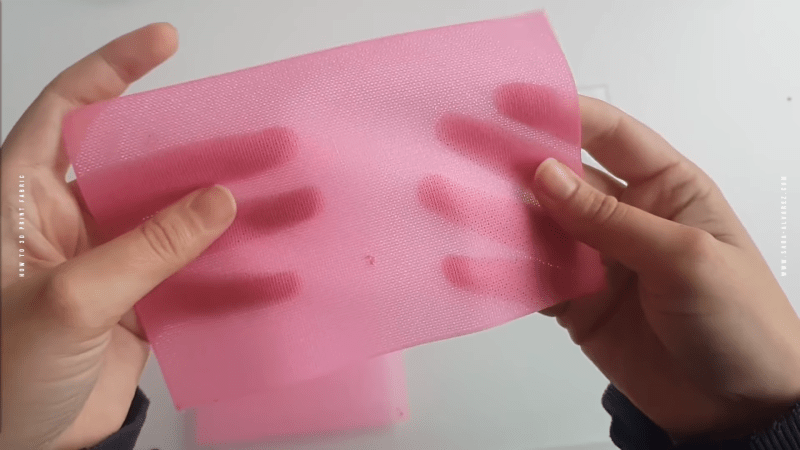Conventional textiles made of woven threads are highly useful materials. [Sara Alvarez] has had some success creating fabric-like materials through 3D printing, and though they’re not identical, they have some similar properties that make them unique and useful.
Fabrics are made by the weaving or knitting together many threads into a cohesive whole. [Sara]’s 3D-printed fabrics are different, since the printer can’t readily weave individual fibers together. Instead, a variety of methods are used to create similar materials.
The simplest is perhaps the chainmail method, where many small individual links join together to make a relatively rigid material. Alternatively, G-code or careful modelling can be used to create fabric-like patterns, which are printed directly in flexible material to become a fabric-like sheet. Finally, the infill method takes advantage of code inbuilt to a slicer to create a pattern that can be 3D-printed to create a fabric like material by removing the top and bottom layers of the print.
[Sara] demonstrates creating a simple “fabric” swatch using the slicer method, and demonstrates the qualities of the finished product. She also shows off various applications that can take advantage of this technique.
If you’re a 3D-printing enthusiast who also loves making clothes and apparel, consider printing up some shoes – like these we’ve seen before. Video after the break.

















I’ve found that a simple 100% solid 0.1mm layer of 95A TPU printed on a textured bed, makes for a relatively fabric-like consistency, no slicing/gcode/geometry tricks needed.
As cool as new techniques are, shouldn’t we be moving *away* from plastics in clothing?
Why? Plastic is easy obtain, light, highly customisable and recyclable. In the context of this article a creator is using it in a highly efficient build on demand manner . If they print to a pattern (in the dressmaking sense) they don’t even have to waste material cutting it to size.
Wearing clothes implying breaking them down little by little and thus create micro-particles, the exact opposite of what we want since micro-plastics are the nastiest thing out there.
This is why I support universal, mandatory nudity.
I suspect you own a lot of stock in the Eye Bleach company!
pla is biodegradable made from corn. also if you recycle your own cloth is sustentable and a km0 technology.
Maybe raw PLA is somewhat degradable, but what we use to print is certainly not. Even raw PLA is only biodegradable in industrial composting conditions. In nature it does not degrade even after 10-20 years.
PLA is biodegradable given industrial composting, it is sadly otherwise extremely durable in the environment
3-D printing techniques could eventually be used with regenerated cellulose (Viscose or Rayon) or polyester, perhaps even spider silk proteins. Plastics are just the polymers we are practicing with.
There is also the defextiles (https://www.media.mit.edu/projects/defextiles/overview/) method, using printing and stringing to crate fabrics with programmable properties (e.g. differential/directional stretch).
I would have concerns with continued skin contact and the type of plastic used. Especially if one is experimenting with using the infill patterns as the exposed material.. or creating any patterns with sharp angles/direction changes.
PLA is _hard_ and sharp, if looked at via a microscope. It is murder on skin. also… people need to stop saying “pla is biodegradable”. It isn’t. Not outside of a high temperature industrial grade pressure cooker. What a plastic is made from does not indicate how bio degradable the resulting plastic is.
Nylon, TPU, and ABS are probably the only plastics that I would even consider wearing from an FDM printer. And that is assuming the source plastic as well as the printer components heating and extruding the plastic are lead free. (Possibly nickel free as well for people who are sensitive to nickel.)
+1 regarding creation of microplastics. The constant rubbing of surfaces, massively increased via the design ideas noted, would generate a good deal of micro plastics.
Having said that, there are probably ways to decrease exposure risk. Say… printing with more than one material to create something that is layered within TPU? Or have the printed material undergo a dip/spray coating of some kind of flexible and skin safe conformal coating.
I’m thinking that you don’t have the 3-d printed material contact the skin at all.
Suppose you 3-d print a T-shirt, then put cloth or non-woven fabric (felt, for example) on the inside. That would make a T-shirt that’s soft and comfortable against the skin, but give you a form-fitted shirt with no seams. A 2nd 3-d printed outer layer could show patterns made by varying the FDM characteristics as it is printed.
Why 3d print fabrics at all? Fabrics are fundamentally 2D materials, fabric objects are formed by connecting these 2d sheets with stitching or glues. Surely laser cutting or other 2d subtractive processes performed on existing fabric sheeting would be a better start?
Fabric may be thin, but it has a 3rd dimension, otherwise wool would be as comfortable as silk. Subtractive processes have more waste than additive process in this case. Pattern pieces would not have to be cut out but printed in the correct shape and size.
If you look at the 3D printing space, we are trying to 3D print everything – even snacks and replacement body parts. Fabric is not really a stretch